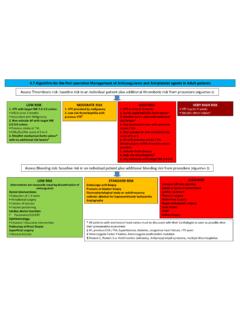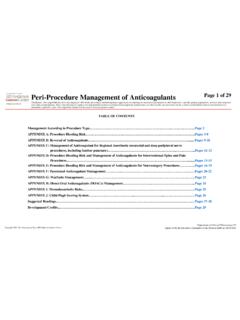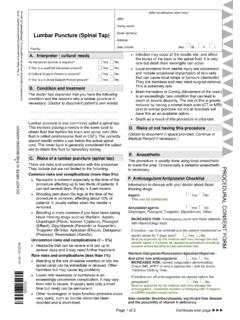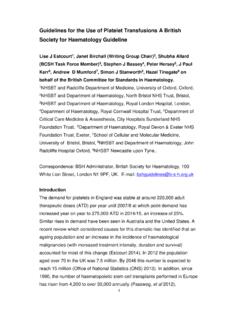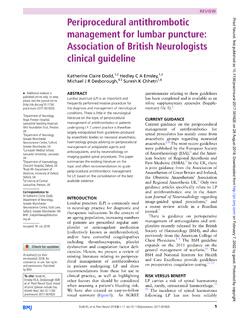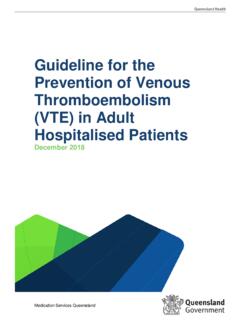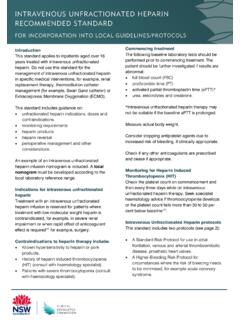Transcription of 4.7 Algorithm for the Peri-operative Management of ...
1 Algorithm for the Peri-operative Management of anticoagulants and antiplatelet agents in Adult patients Assess Thrombosis risk: baseline risk in an individual patient plus additional thrombotic risk from procedure ( Algorithm 1) LOW RISK 1. VTE with target INR unless: VTE in prior 3 months Associated with Malignancy 2. Non-valvular AF with target INR unless: Previous stroke or TIA CHA2DS2 VASc score of 5 or 6 3. Bileaflet mechanical Aortic valves* with no additional risk factors MODERATE RISK 1. VTE provoked by malignancy 2.
2 Low risk thrombophilia with previous VTE HIGH RISK 1. VTE in prior 6-12 weeks 2. Aortic caged ball/disc heart valves* 3. Bileaflet aortic valve with additional risk factors* 4. Any mechanical valve with previous stroke / TIA 5. Non-valvular AF with CHA2DS2 VASc score of 5 or 6 6. AF with previous stroke / TIA (Avoid surgery within 3 months where possible) 7. Valvular heart disease 8. High risk thrombophilia 9. Any indication with target INR VERY HIGH RISK VTE in prior 6 weeks Metallic Mitral Valves* * All patients with mechanical heart valves must be discussed with their Cardiologist as soon as possible after their preoperative assessment AF, previous CVA / TIA, hypertension, diabetes, congestive heart failure, >75 years Heterozygote Factor V Leiden, heterozygote prothrombin mutation Protein C, Protein S or Antithrombin deficiency, Antiphospholipid syndrome, multiple thrombophilias Assess Bleeding risk.
3 Baseline risk in an individual patient plus additional bleeding risk from procedure ( Algorithm 2) LOW RISK (Interventions not necessarily requiring discontinuation of anticoagulant ) Dental Interventions: Extraction of 1-3 teeth Periodontal surgery Incision of abscess Implant positioning Cardiac device insertion: Pacemaker/ICD/CRT Ophthalmology: Cataract / Glaucoma intervention Endoscopy without biopsy Superficial surgery: Abscess incision Small dermatological incision HIGH RISK Complex left side ablation Spinal or epidural anaesthesia Lumbar puncture Thoracic surgery Abdominal surgery Major orthopaedic surgery Liver biopsy TURP Kidney biopsy STANDARD RISK Endoscopy with biopsy Prostate or bladder biopsy Electrophysiological study or radiofrequency catheter ablation for Supraventricular tachycardia Angiography STANDARD RISK Endoscopy with biopsy Prostate of bladder biopsy Electrophysiological study or radiofrequency catheter ablation for Supraventricular
4 Tachycardia Angiography Pacemaker or ICD implantation Algorithm for Managing Anticoagulation Perioperatively Assess patients at least 14 days before surgery Is the patient prescribed: an anticoagulant ? Or an antiplatelet ? VKAs: Warfarin, Acenocoumarol and Phenindione See Appendix 1 Anticoagulants Antiplatelets DOACs: Rivaroxaban, Apixaban and Dabigatran See Appendix 2 Parenteral anticoagulation: Fragmin and Fondaparinux See Appendix 3 Aspirin/Prasugrel Dipyridamole Clopidogrel/Ticragelor See Appendix 4 Perioperative Management proforma must be completed and given to Patient, copy sent to GP, Surgeon / Operator and a copy filed in the Patient's notes The proforma should contain calendar outlining the Perioperative timing of.
5 anticoagulant and antiplatelet discontinuation and resumption Dose and timing of LMWH bridging (where relevant) INR measurement schedule (where relevant) All patients or caregivers must receive adequate education on injection technique when outpatient LMWH bridging is administered. Ensure sharps bins are provided Ensure contact details are available in case of bleeding or queries Algorithm for Managing patients on VKAs (Warfarin, Acenocoumarol and Phenindione) Appendix 1 The target INR must be stipulated by the team carrying out the invasive procedure.
6 If required INR is less than the target range: Weigh patient and calculate creatinine clearance (CrCl) (not estimated GFR) If metallic heart valve discuss with Cardiology prior to proceeding; if dialysis patient discuss with Renal team LOW RISK 1. Stop Warfarin 5 days before surgery to allow INR to normalise 2. Take INR 1 day prior (ideally) or the morning of the procedure (urgently) 3. If INR is higher than required by Operator then discuss with Consultant Haematologist / Haematology SpR for advice regarding dose of Vitamin K MODERATE RISK 1. Stop Warfarin 5 days before surgery to allow INR to normalise 2.
7 Start prophylactic dose (usually 5 000u) Dalteparin 3 days pre-operatively (prescribe ) 3. Take INR 1 day prior (ideally) or the morning of the procedure (urgently) 4. If INR is higher than required by Operator then discuss with Consultant Haematologist/Haematology SpR for advice regarding dose of Vitamin K 5. On day of procedure omit LMWH dose at HIGH RISK 1. Stop Warfarin 5 days before surgery to allow INR to normalise 2. Start treatment dose Dalteparin 3 days pre-operatively (prescribe ) ** Use Table 1 for Dalteparin dose. If UFH required admit patient 3 days pre-operatively (use Trust Guideline: Use of intravenous heparin) If CrCl <50ml/min omit for 48h no fragmin on day of operation or day prior to operation 3.
8 Take INR 1 day prior (ideally) or the morning of the procedure (urgently) 4. If INR is higher than required by Operator then discuss with Consultant Haematologist/Haematology SpR for advice regarding dose of Vitamin K 5. On day of procedure omit LMWH dose at If CrCl<50ml/min omit for 48hrs. If UFH used, stop 6 hours prior to procedure (APTT not required) VERY HIGH RISK 1. VTE in prior 6 weeks: Ideally avoid surgery Consider use of temporary Inferior Vena Cava (IVC) Filter. Refer to guidelines Algorithm for Insertion of Retrievable Vena Caval Filters Then manage as per High risk (see above) 2.
9 Metallic Mitral Valves All patients with Metallic Heart valves should be discussed with their Cardiologist prior to surgery. LMWH is unlicensed in metallic valves; UFH may be preferable Then manage as per High risk (see above) Assess Thrombotic risk utilising Algorithm 1 Pre-operative Management : LOW RISK 1. Consider prophylactic dose Dalteparin post-operatively as per MTW VTE prevention guidelines 2. Recommence usual Warfarin dose on evening of surgery if no excessive bleeding. This must be discussed with a Surgeon MODERATE RISK 1.
10 Restart LMWH or UFH 6-8 hours post-operatively if haemostasis secure 2. If epidural or spinal blockade used, treatment dose LMWH or UFH should be restarted at least 12 hours post catheter removal - this should be delayed to 24 hours if traumatic epidural insertion If bleeding occurs (or high risk of bleeding) post operatively then it may be necessary to delay recommencement of anticoagulation OR use prophylactic Dalteparin doses OR UFH infusion until bleeding risk diminishes If bleeding risk intermediate / low then use split doses of Dalteparin (50% therapeutic dose twice daily)
